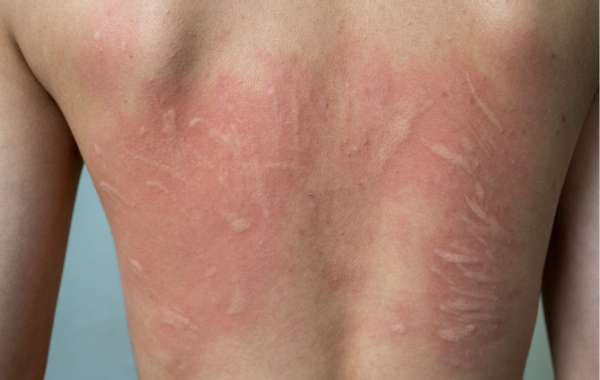Urticaria, commonly known as hives, is a skin condition characterized by raised, itchy welts that can appear suddenly and resolve within hours or persist for weeks. It affects approximately 20% of people at some point in their lives, with triggers ranging from allergens to stress or infections. Managing urticaria involves identifying triggers, alleviating symptoms, and preventing recurrence.
This article explores the best treatments for urticaria, including pharmacological and non-pharmacological approaches, with a focus on integrating the role of Ceftriaxone injection in specific cases.
Understanding Urticaria
Urticaria occurs when mast cells in the skin release histamine, causing vasodilation and leakage of fluid into the dermis, forming welts. Acute urticaria lasts less than six weeks and is often triggered by food allergens, medications, insect bites, or infections. Chronic urticaria persists beyond six weeks and may be autoimmune, idiopathic, or linked to underlying conditions like thyroid disease. Effective treatment requires addressing the underlying cause, controlling symptoms, and preventing complications like angioedema, a deeper swelling that can affect airways.
Non-Pharmacological Treatments
1. Trigger Identification and Avoidance
The first step in managing urticaria is identifying and avoiding triggers. Common culprits include:
Foods: Shellfish, nuts, eggs, or dairy.
Medications: NSAIDs, antibiotics, or ACE inhibitors.
Environmental factors: Pollen, pet dander, or dust mites.
Physical stimuli: Heat, cold, pressure, or sunlight.
Patients are advised to keep a symptom diary to pinpoint triggers. For example, if hives appear after consuming shellfish, an allergist may recommend avoidance and testing for specific IgE antibodies. Environmental control, such as using hypoallergenic bedding or avoiding extreme temperatures, can reduce flare-ups.
2. Lifestyle Modifications
Stress is a known exacerbating factor for urticaria. Relaxation techniques like yoga, meditation, or cognitive-behavioral therapy can help manage stress-induced flares. Wearing loose, breathable clothing and avoiding hot showers can minimize skin irritation. A balanced diet rich in anti-inflammatory foods, such as omega-3 fatty acids, may also support skin health.
Pharmacological Treatments
1. Antihistamines
Antihistamines are the cornerstone of urticaria treatment, targeting histamine to reduce itching and welts. Non-sedating second-generation antihistamines, such as cetirizine, loratadine, or fexofenadine, are preferred for daytime use due to their efficacy and minimal side effects. For severe cases, higher-than-standard doses (up to four times the usual dose) may be prescribed under medical supervision. Sedating first-generation antihistamines like hydroxyzine are useful for nighttime relief, especially when itching disrupts sleep.
2. Corticosteroids
For acute flares unresponsive to antihistamines, short-term oral corticosteroids like prednisone (e.g., 20–40 mg daily for 3–7 days) can rapidly reduce inflammation. However, long-term use is avoided due to side effects like weight gain, osteoporosis, and adrenal suppression. Topical corticosteroids are less effective for urticaria but may help with localized symptoms.
3. Leukotriene Receptor Antagonists
Montelukast, a leukotriene receptor antagonist, is sometimes added for patients with poor response to antihistamines. It works by blocking leukotrienes, inflammatory mediators involved in urticaria. Studies show modest benefits, particularly in aspirin-induced urticaria.
4. Immunomodulators
Chronic urticaria, especially autoimmune cases, may require immunomodulatory therapies:
Omalizumab: A monoclonal antibody targeting IgE, omalizumab is highly effective for chronic spontaneous urticaria. Administered monthly via subcutaneous injection, it reduces mast cell activation. Clinical trials report 60–80% symptom resolution within weeks.
Cyclosporine: Reserved for severe, refractory cases, cyclosporine suppresses immune activity but requires monitoring for side effects like hypertension and renal toxicity.
5. Role of Ceftriaxone Injection
In cases where urticaria is secondary to bacterial infections, such as streptococcal pharyngitis or sinusitis, antibiotics like ceftriaxone injection may be indicated. Ceftriaxone, a third-generation cephalosporin, is administered intramuscularly or intravenously, typically at a dose of 1–2 grams daily for 5–7 days, depending on the infection’s severity. It is particularly useful in hospitalized patients or those with systemic symptoms, such as fever or elevated C-reactive protein, indicating an infectious trigger.
For example, urticaria associated with group A Streptococcus infections may resolve after Ceftriaxone eradicates the underlying infection. However, Ceftriaxone is not a first-line treatment for urticaria itself, as most cases are not infection-related. Clinicians must confirm the infectious cause through cultures or serology before prescribing Ceftriaxone, as inappropriate antibiotic use can lead to resistance or side effects like diarrhea or allergic reactions. Notably, Ceftriaxone itself can rarely trigger urticaria in penicillin-allergic patients due to cross-reactivity, requiring careful patient history review.
Emerging Therapies
1. Biologics
Beyond omalizumab, other biologics targeting pathways like IL-5 (mepolizumab) or IL-4/IL-13 (dupilumab) are under investigation for chronic urticaria. Early trials suggest dupilumab may benefit patients with coexisting atopic dermatitis.
2. Janus Kinase (JAK) Inhibitors
JAK inhibitors, such as upadacitinib, are being explored for their ability to modulate inflammatory pathways in urticaria. These are not yet standard but show promise in refractory cases.
Management of Special Cases
1. Angioedema
Angioedema accompanying urticaria requires urgent attention, especially if it involves the throat or tongue. Antihistamines and corticosteroids are first-line, but epinephrine may be needed for airway compromise. In hereditary angioedema, C1 esterase inhibitors or bradykinin receptor antagonists are used.
2. Pediatric Urticaria
Children with urticaria are treated similarly but with weight-adjusted doses. Second-generation antihistamines are preferred, and Ceftriaxone injection may be used for infection-related cases, typically at 50–100 mg/kg daily, not exceeding adult doses.
3. Pregnancy
Pregnant women with urticaria require careful management. Loratadine and cetirizine are considered safe, while corticosteroids are used sparingly. Omalizumab has limited data but may be considered in severe cases. Ceftriaxone is generally safe in pregnancy (Category B) but should only be used for confirmed infections.
Monitoring and Follow-Up
Regular follow-up is crucial, especially for chronic urticaria. Patients should be monitored for treatment response, side effects, and new triggers. Laboratory tests, including complete blood count, thyroid function, and autoimmune markers, may help identify underlying causes. If Ceftriaxone injection is used, follow-up includes assessing infection resolution and monitoring for adverse reactions like rash or gastrointestinal upset.
Patient Education
Educating patients about urticaria empowers them to manage their condition. Key points include:
Recognizing early signs of flares and using antihistamines promptly.
Avoiding known triggers and maintaining a symptom diary.
Understanding that Ceftriaxone injection is reserved for infection-related cases and not a routine treatment.
Seeking immediate care for angioedema or breathing difficulties.
Conclusion
The best treatments for urticaria combine trigger avoidance, lifestyle changes, and targeted pharmacotherapy. Antihistamines remain the mainstay, with corticosteroids, omalizumab, and other immunomodulators used for severe or chronic cases. Ceftriaxone injection plays a niche but important role when urticaria is driven by bacterial infections, requiring careful diagnosis to ensure appropriate use. By tailoring treatment to the patient’s needs and addressing underlying causes, clinicians can achieve symptom control and improve quality of life. Ongoing research into biologics and JAK inhibitors promises further advancements in urticaria management.








